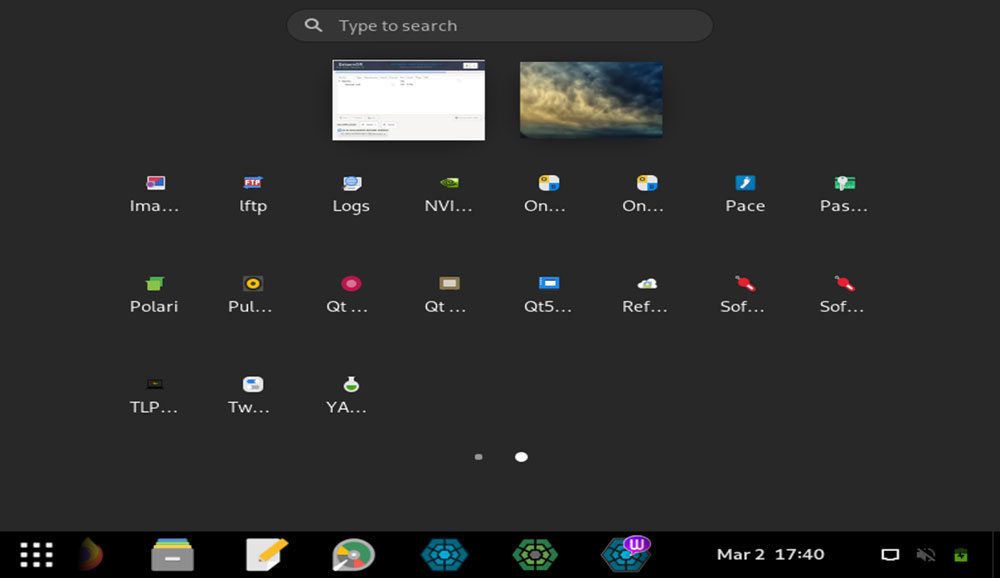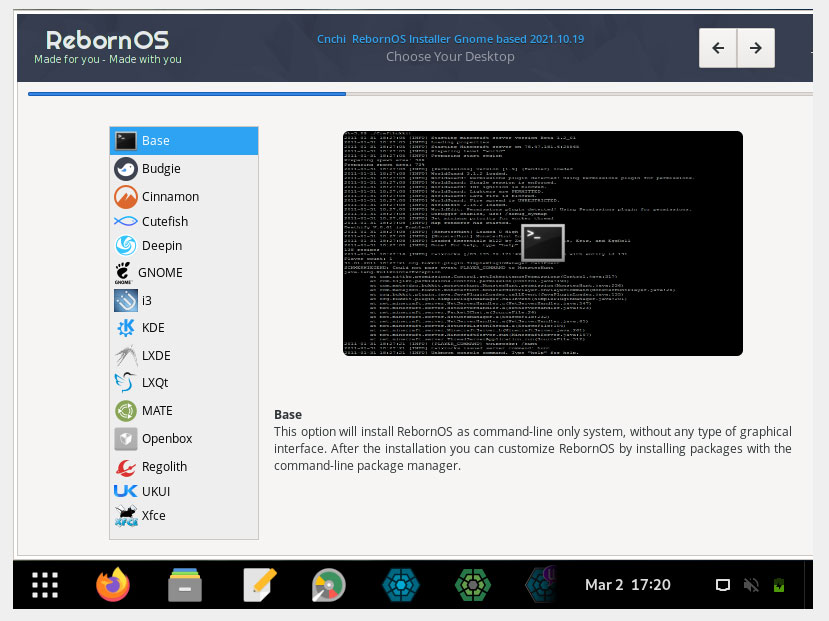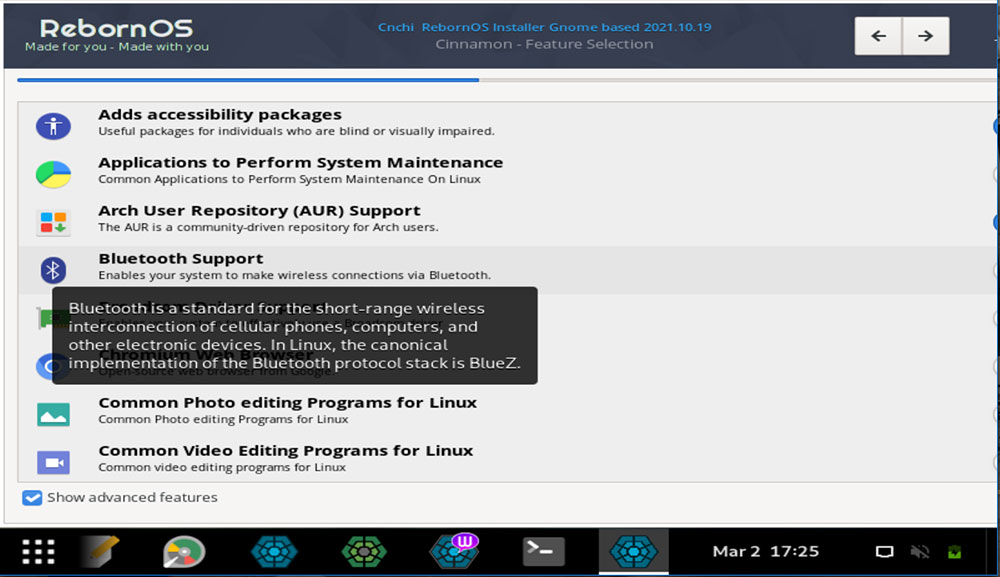RebornOS is a Linux distro hopper’s dream computing machine. It is also a great alternative for seasoned Linux users looking for a new option and for newcomers who do not mind tinkering.
One of my pet peeves with Linux distributions that support multiple desktop environments is the hassle of swapping out different installation DVDs (ISOs) to check out unfamiliar desktop options. That process involves downloading each desktop version, burning the ISO file to a new DVD, and installing it to the hard drive, virtual machine, or live session.
A scant few distros offer an alternative design. This method lets you alter desktops from within the default version by running scripts that swap out themes and some essential components to change the appearance. This approach has little impact on changing the key features of each desktop, though.
RebornOS changes the desktop functionality relatively well without having to reinstall the entire Linux platform. One of the few Linux developers to succeed at this process is Jacque Montague Raymer, who created MakuluLinux Shift.
Raymer’s Shift distro has an application that lets users select from a variety of embedded desktops. Click a choice, the screen goes dark for 30 seconds or so, and the changed desktop view appears.
RebornOS does this function a bit differently. During the initial installation, pick the desktop you want to use. It is there waiting for you when the installation finishes. You can change to another desktop and merely reboot the system to complete the change without reinstalling from scratch.
Having numerous desktop options embedded in one ISO download is priceless. But RebornOS, despite its short time in existence, has so much more to offer.
Phoenix-like Revival
RebornOS is a relative newcomer based on Arch Linux. Arch, of course, is notorious for being user-unfriendly. A handy part of RebornOS’ design seeks to change that reputation by making installation simple. It makes numerous system maintenance elements easier to handle.

The default GNOME application menu’s display truncates the titles until the mouse hovers on the icon.
Several modern Arch-based distros have the same strategy. This one, however, leaves those competitors trailing behind. It combines an efficient installation routine with a rolling release structure that always keeps software up to date without major upgrade installs.
Diehard Linux users no doubt see the irony in the distro’s name. It suggests the developing team’s passion for bringing new life to a litany of tired Linux retread platforms. But its name also hints at its lineage.
The founding creator developed RebornOS as an unofficial replacement for Antergos Linux that died a few years ago. The birth of RebornOS came on the heels of Endeavor Linux’s arrival as an Antergos replacement.
Youthful to the Core
Much like some hackers who hide their true identities in mysterious code names, the developer team at RebornOS seems to lurk in the shadows. Their IDs are listed as first names with very little exposed details.
This is not totally uncommon among open-source communities. But it does add to the mystery surrounding this novel distro.
Take, for instance, the creator of RebornOS. I had to read between the lines of meager details available on the website and other internet hangouts.
The distribution founder and head developer was Keegan, who seems to have gotten involved in Linux as a teenager and released the infant operating system while still a student around 2018. He left the project for personal reasons circa June 2020, according to spotty details in the threads of news announcements on the developer’s website.
Rafael, who was on board originally in other capacities, is now listed as author at RebornOS and elsewhere as the head developer. Other online references and discussions about RebornOS include his full name as Rafael Costa Rega.
I found several early distro videos posted on YouTube by the same name. One of those is here.
Distro Details
As noted earlier, one of the more impressive aspects of RebornOS is its ability to take the pain and confusion out of the installation process. That success includes configuring system settings and the applications.
Another bright spot in getting started using this newcomer distro is a sense of building a computer platform from scratch without compiling files to install them. A major part of the installation routine involves toggling software applications you want to use and system preferences for how RebornOS works.
Select the desktop you want. The picklist has 15 options. If you pick none of them, GNOME will install by default.

RebornOS is all about choices that include an ample selection of desktop environments.
Much of this procedure is orchestrated by a modified version of the graphical installer Cnchi. The installer originally came from the team that developed the now-defunct Antergos Linux. It is visually similar to Ubuntu’s Ubiquity wizard. However, the sliders located on the right side of the selection window are not fully visible.

The Cnchi installer barely displayed the sliders on the far right of the selection window.
RebornOS is available as a single hybrid ISO image with a size of about 2.1 GB, which is designed for 64-bit hardware only. The 2.3 GB ISO that boots into a GNOME-based live environment is configured with a combined dock and panel at the bottom.
The computer must be connected to the internet for installation because it needs to retrieve most data from online sources to install the system.
Linux Your Way
Customizing your software is yet another attraction of RebornOS. The available software depends on the selected desktop environment. That interface also determines the utilities that populate the menus.
The selection wizard uses a non-standard tool. It displays a list of frequently used applications from which you use toggles to include the desired programs from the list in the installation.
Choices include several office suites, such as LibreOffice, Softmaker’s FreeOffice, or the Chinese WPS Office. Browser choices include Google’s Chrome and its free counterpart Chromium, plus Opera and its offshoot Vivaldi.
You also can select which online services you want installed. In that list are Dropbox, Steam, and Spotify, among other options.
RebornOS enables Flatpak package management by default within desktops that support that software distribution and package management method. GNOME is the default desktop if you do not choose any of the alternatives.
When you first run the OS, a window opens that lets you integrate the Flatpak repository into the GNOME software store. You can uncheck this option in the window.
Enabling Flatpak lets the GNOME software front end automatically check for updates in the background. The update management system notifies you; then you can use the Pamac graphical front end to view and install whatever you need.
Bottom Line
RebornOS is a unique Linux platform that has much to offer. It goes well beyond the concept of the Linux legacy being all about freedom of choice.
Your desktop choice can also affect system performance and features. Some of the options draw more heavily on system resources. Others are more lightweight and provide fewer frills.
The live session experience suggests that RebornOS is devoid of standard applications. The default GNOME environment can be somewhat unimpressive.
Push beyond that initial negative impression. Much of this distro’s power and uniqueness is not evident until you install it.
Want to Suggest a Review?
Is there a Linux software application or distro you’d like to suggest for review? Something you love or would like to get to know?
Please email your ideas to me and I’ll consider them for a future column.
And use the Reader Comments feature below to provide your input!
























































